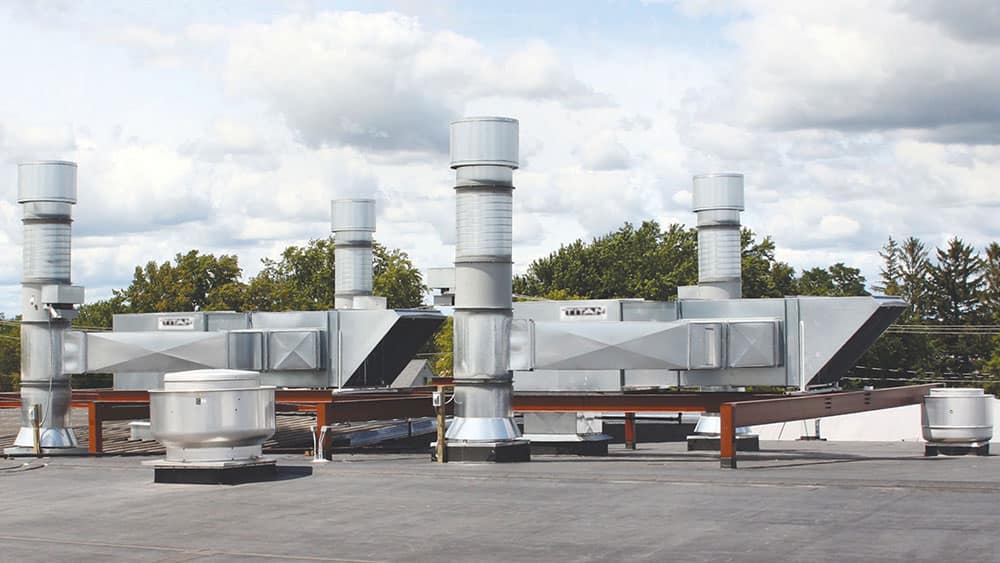
Whether you are looking to purchase a new paint booth or have a current booth without an air replacement system, it is important to understand how the air that is exhausted from your paint booth is or will be replaced. Replacement air can be pulled directly from your facility or it can be pulled from outside of your building and filtered through an air make-up unit (AMU).
An air make-up unit allows for environmental temperature control in a paint booth during coating application and curing. AMUs maintain a constant leaving-air temperature regardless of the incoming, outdoor air temperature and replenish equal amounts of fresh air for every cubic foot of air exhausted.
“If it is 20 degrees Fahrenheit outside in the winter, you don’t want to bring that cold air into your building,” said Royce Day, industrial project manager for Global Finishing Solutions (GFS). “And in the summer, you don’t want pollen, dust and dirt coming into your spray booth through open doors or louvered wall vents.”
Another advantage of an air make-up unit for your paint booth is that the quality of the coatings is not adversely affected, thanks to conditioned, filtered air that is supplied to the paint booth. With a fresh air make-up unit, there is no need to draw air from the facility, which improves working conditions and lowers operating costs.
Heated AMUs minimize temperature variations in the spray booth. This helps ensure the paint finish quality is not compromised, as only filtered air that is free of contaminants enters the booth.
Even when paint finishing quality is not a priority — e.g., for manufacturers that paint steel beams — air replacement is still a necessity. The air that is exhausted must be replaced with outside air, per code requirements.
“The only reasons a business initially chooses not to have an AMU is because they plan to add an AMU later on or they don’t currently have enough production to warrant it,” said Day. “Other than that, there is no reason not to have an AMU, and it is required by the International Mechanical Code (IMC) to replace air when you are exhausting it out of a building.”
How much air a paint booth exhausts depends on the size of the spray booth. The larger the paint booth, the more air that needs to be supplied. Even a small spray booth may exhaust more than 8,000 cubic feet of air per minute (CFM), while some large paint booths may exhaust more than 20,000 CFM.
Paint booth design is critical, as the calculated air volume may be too much or too little in a booth that is improperly designed, causing operational inefficiency and poor airflow within the spray booth. Likewise, a paint booth air make-up unit should be designed to meet NFPA 86 standards, which pertain to the minimization of fire and explosion hazards of industrial ovens and furnaces.
Another important factor is the placement of larger fresh air make-up units, some of which exceed 20 feet in length and weigh as much as 50,000 pounds. If a building’s roof cannot support the weight of an AMU, the AMU is typically mounted vertically alongside the building, on a platform inside the building or on top of the booth itself. To draw sufficient air from the outside, an indoor AMU requires an intake duct from the roof line or adjacent wall to the intake of the AMU.
Understanding paint booth AMU requirements is a good first step to a productive shop. Next, a paint booth manufacturer, such as GFS, or a local distributor can help you determine which size AMU is best for your building. They will evaluate your facility and your production requirements, and select an AMU that is sized right for your operation. With an air make-up unit from GFS, you will be better positioned to maintain paint finish quality and reduce temperature variations in your spray booth, while also saving energy.
One of the best ways to highlight your business is through a story that you can share across your online platforms. It humanizes your business and shows that your business can make a meaningful impact. Your testimonial would be used as a project profile on the GFS Booth Blog and can be shared on your website and/or social media channels.
Complete this form and we’ll be in touch to showcase your company.

Shop a variety of GFS aftermarket products, including booth protection products and mobile accelerated curing units. And enjoy the convenience of fast and free ground shipping throughout the contiguous United States.

Located at GFS’ headquarters in Osseo, Wisconsin, the Center for Excellence is an innovative facility featuring an automotive refinish training center, as well as a separate space dedicated to technical product training.

GFS is continuously searching for talented, ambitious individuals to join our team. We aim to provide our employees with every opportunity to make an impact on the company and find their niche along the way — weather in a production, field services or an office position.